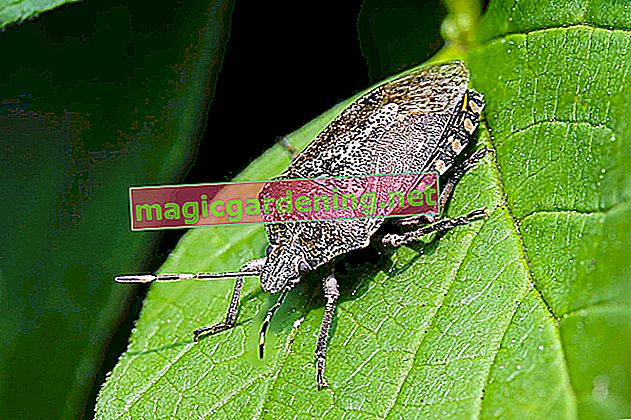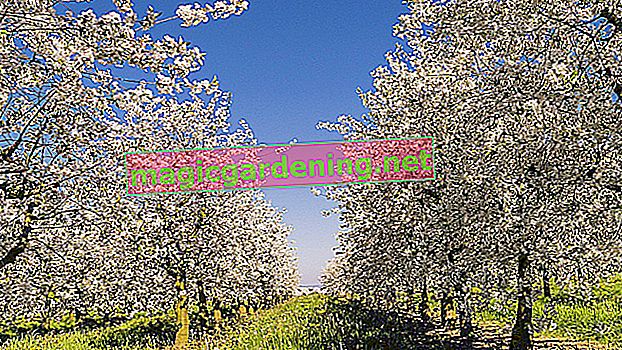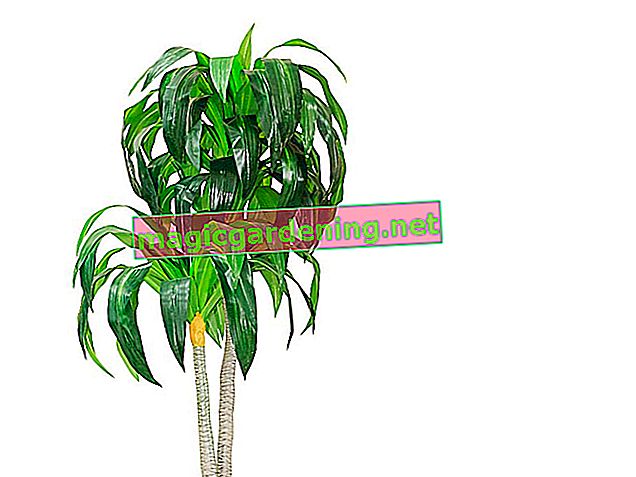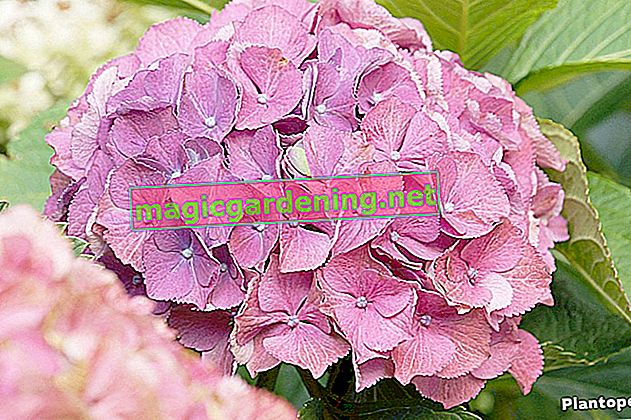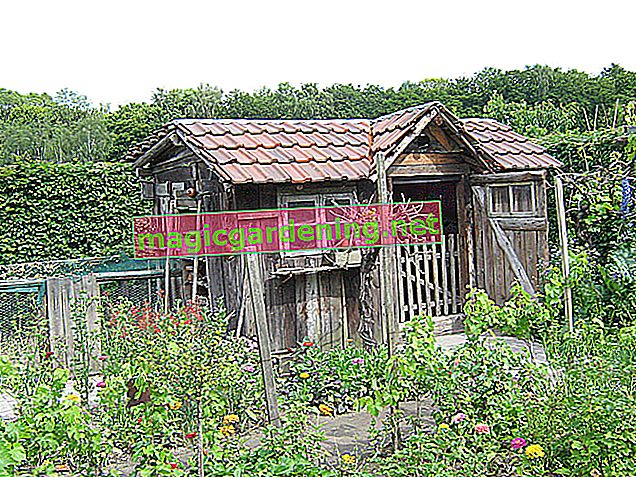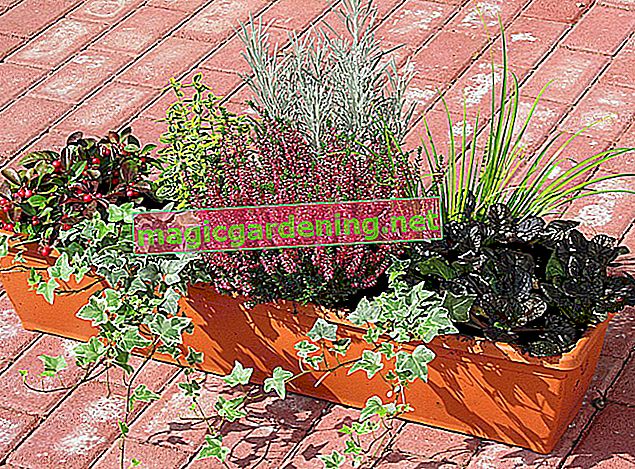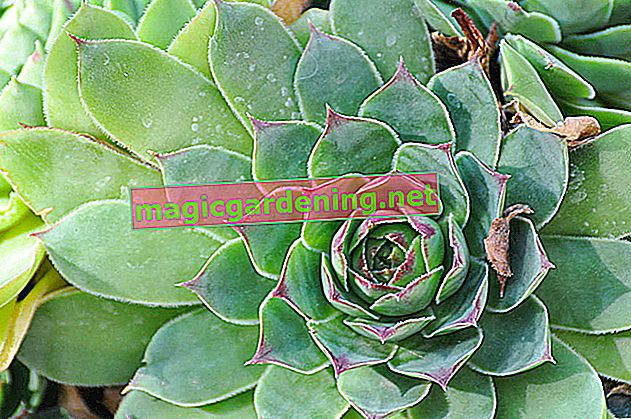
origin
The Echeverie is mainly native to Mexico, where it inhabits dry rock areas from 500 to 3000 meters in height. Their distribution area also extends north and south of it - some species can also be found in the south of the USA, especially in Texas, or in northern South America, for example in Peru. In its original habitat with little rain, it has adapted to the circumstances with its fleshy, water-storing leaves.
also read
- Proper care of Echeveria agavoides
- Water the Echeveria sparingly
- The echeveria comes in innumerable species
Of course, this has advantages for the local houseplant culture, as you don't have to look after them much. An ideal greening for everyone who cannot / do not want to spend a lot of leisure time caring for indoor plants.
To note:
- comes from dry rock areas, especially Mexico, southern USA and northern South America
- is therefore very frugal, hardly needs any attention
growth
Echeveria belong to the thick-leaf plant family and are usually evergreen succulents. Typical of its appearance is its low, compressed, rosette-like growth, which makes it look like it is nestled against the ground. As a rule, the echeveria only stays 10 to 15 cm high. However, some species also grow as small shrubs.
leaves
The leaves of the echeverie are the most important thing for ornamental gardening purposes. They are extremely shapely, both as a single copy and together in the rosette arrangement. About twentieth they stand together above the compact stem axis and have a mostly triangular to inverted egg-shaped, tapering in front. Overall, they form a 7 to 10 cm wide rosette.
Since the leaves of the plant serve as a water reservoir, they have a thick-fleshed consistency typical for leaf succulents. They have a high water holding capacity and allow the Echeverie to survive long dry phases without complaint. However, the succulent structure of the leaves also makes them fragile. So always handle the leaf rosette as carefully as possible. The leaves of some species have downy hairs.
In terms of color, the leaves usually appear in a matt, light green, sometimes also in grayish-bluish green tones or in purple-tinged red tones. The leaf edges and tips of the green varieties are often slightly reddish in color.
Blade properties at a glance:
- mostly triangular to inverted egg-shaped
- together form a 7-10 cm wide rosette of leaves
- thick-fleshed consistency, slightly fragile
- high water storage capacity
- light green to bluish, greyish and reddish colors
blossoms
From spring to early summer, roughly between March and June, the Echeveria shows rather showy, pretty inflorescences that grow on a long stem from the lateral leaf axils. The stems can be up to 3 cm long, so that the flowers are enthroned high above the low leaf rosette. At the end of the stem, several flowers in mostly reddish to pink tones, sometimes orange-yellow to greenish colors, are usually formed like grapes. The flower clusters hang over like a bell.
Flower characteristics in key words:
- Flowering time from early spring to early summer
- racemose inflorescences on tall stalks
- Colors vary from red to orange, yellow and green
Location
Echeveria are used to a lot of sun from their original habitat. You should therefore treat your plant to the brightest possible location in your room. The Echeverie has no objection to constant sun exposure and heat. A place near a large window, if possible facing south, is ideal for them. You can also put it outside over the summer, but it should be protected from rain there.
In terms of temperature, the Echeverie likes it - no wonder - warm. With year-round cultivation in a warm room, you are on the safe side. But she likes it a little cooler over the winter. Around 15 ° C are better here, especially if you value flowering in the following spring.
Site requirements at a glance:
- warm and sunny
- dry - so keep it sheltered from the rain if there is temporary outdoor culture in summer
- a little cooler in winter (cold stimulus for flower formation)
earth
Echeveria require a well-drained, mineral substrate with moderate nutrient content. Cactus soil from specialist shops is ideal if you mix it yourself, use some compost soil, coarse sand and, if necessary, some volcanic rock.
to water
When it comes to water, the Echeverie is a true ascetic. It gets by with very little watering, which makes it ideal for people who travel a lot. Basically, you only need to water sporadically - and only when the substrate is completely dry. Because as with many other thirstless plants, the rule of thumb also applies to the Echeverie: too little is always better than too much. If it gets too much water, the echeveria will show it pretty clearly by fading the leaves.
The succulent plant doesn't like it when its leaves get a cold shower - so just pour on the soil. Otherwise, the leaf rosette can also rot.
In winter you hardly need to water at all.
Casting practice at a glance:
- Pour very little
- Pour only onto the substrate, not into the leaf rosette
- Quasi stop watering in winter
Fertilize
The Echeverie does not actually need to be fertilized. But if it has been in a pot for more than 2 years, you can treat it to some nutritional supplements over the summer months. To do this, use gentle fertilizers, either cactus fertilizers from specialist shops or organic fertilizers from your own household and garden such as coffee grounds, compost or nettle manure. The fertilizer application frequency is based on the amount of water applied - so only very occasionally. From September you should stop applying fertilizer.
To note:
- It is advisable to add some fertilizer in a pot from the second year onwards
- Use gentle cactus fertilizer, compost, coffee grounds or nettle manure
- Only over the summer months, parallel to the watering intervals
Repot
If you want to do something good for your Echeverie, you should treat it to a new substrate every two years. The plant seldom really needs more space, rather the used substrate is the reason to move the pot. Put the echeveria in a new mixture of compost and sand in the spring.
To cut
The Echeverie doesn't need a cut itself. Their compact rosette growth does not encourage you to do so. However, what you can do to take care of the plant is to remove old and dry parts. This includes dead inflorescences and disused leaves. You don't need to cut these with a cutting tool. It is better to just pluck them out.
To note:
- The Echeverie doesn't need topiary
- Only remove old, dried up parts of the plant, preferably by plucking out
Hardy
Echeveria are of course not hardy. None of the different species is frost-hardy - permanent planting in the open is therefore not possible. The wintering quarters in the house must also be frost-free, even if the plant likes it cooler there.
Temporary planting out in summer is of course possible and, given the small, compact size of the plant, not particularly laborious. Echeveria can be used to enrich sunny rock garden designs around the terrace in an attractive way. Wait for the ice saints in May to plant out. As soon as the first night frosts are announced in autumn, dig up the echeveria again and bring them into the house.
To note:
- Echeveria are not hardy
- Always protect from frost
- Can be planted in summer between ice saints and the first frosts in autumn
Multiply
Daughter rosettes
Echeveria form some daughter rosettes in the pot over time and thus multiply by themselves. You can simply dig out the daughter rosettes and put them in new pots.
Cuttings
If the Echeverie does not have daughter rosettes to offer at the time you get an offshoot for your plant collection or you want to give it to someone else, there is also the option of cuttings. To do this, pluck a leaf out of the rosette and put it in a planter with a peaty, sandy substrate. Place the nursery pot warm and bright.
Seed cultivation
You can also grow echeveria from seeds. However, some varieties do not produce fruitful seeds, so if you want to be on the safe side, you should use seeds from specialist shops. Put the seeds in a sandy growing medium (9.05 € at Amazon *) that they keep moderately moist. They germinate best at around 18 ° C.
Diseases
The Echeverie is pleasantly resistant to disease, which increases its attractiveness for less dedicated house plant enthusiasts. What is most likely to bother her is too much water, which can lead to mold and rot.
Pests
Echeveria is also less susceptible to pests. Aphids may appear on the inflorescences during the flowering period. You can recognize the small reddish to blackish or greenish insects by the honeydew, which they secrete by sucking the sap and stick to the leaves and window sill.
The best way to combat aphid infestation is first mechanically by spraying the plant. If the infestation is more advanced, you can use neem oil-based preparations or a mixture of water and potassium soap. This will suffocate the pests.
Alternatively, you can also use plant protection sticks. You just need to stick these in the soil so that they gradually release their active ingredient, which is toxic to the lice, to the plant.
Toxic
Echeveria are quite slightly poisonous, although that also depends on the respective species. The toxin content is low, however, so that they do not pose any really serious danger. To be on the safe side, you should take certain precautionary measures when living with small children or pets. Place the Echeverie in a high place that is not accessible to the curious roommate.
The substances contained in the plant sap can primarily cause skin irritation, but there is no life-threatening risk of poisoning. When removing old inflorescences, work with gloves if necessary, especially if you are generally sensitive to skin irritation.
eat
Echeveria should of course not be eaten in view of its low toxicity. However, there is not really much to worry about here either. Because even when parts of plants are consumed, mucous membrane irritation remains at best, but there is no risk of fatal poisoning. The consumption dose required for this would hardly be eaten.
tip
To protect the echeveria from leaf rot, it is advisable to cover the substrate on top with a layer of sand. This also underlines their exotic character.
sorts
In garden centers, hybrid forms from different species of echeveria are mostly sold. In general, however, they are categorized according to a total of around 150 species belonging to the genus Echeveria. The most popular and most common species and cultivars are:
Echeveria agavoides
This species is very representative of its genus: With its 10 cm long, triangular, pointed leaves, it forms a neat, neatly structured rosette about 12 cm in diameter. At about 10-12 centimeters in height, it remains quite low. In particularly sunny locations, the edges of the bright, fresh green leaves turn reddish in color.
The flowers appear between March and April in bell-shaped, orange-red to pink-colored flower clusters on tall stems.
Well-known cultivars of this type are, for example, the varieties E. a. Multifida with numerous, lush, amber-colored and brick-red-edged leaves and E. a. Prolifera with orange-colored leaf margins.
Echeveria harmsii
The E. harmsii stands out from other Echeveria species by its rather loose, not so compact growth. Its leaves have a slender, inverted egg-shaped shape with a moderately pointed end and form an airy rosette with loosely spaced one another. In addition, they are covered by a silvery hair, which makes them look downy.
E. harmsii has a shrubby habit with a slender trunk and is around 30 to 50 cm high.
In May to June, for example, high-stemmed inflorescences of about 15 cm in height with scarlet, yellow-tipped flowers that are not clustered like most echeverias, but stand individually.
Echeveria elegans
E. elegans, on the other hand, has a very compact, stemless growth with a compact rosette of leaves about 10 centimeters in diameter. The single leaves are only 2 to 5 cm long and form an attractive structure thanks to their spatula-like edge with a long tip. In comparison to those of other Echeveria species, the leaves are also relatively flat and staggered close together in the center of the rosette. Their color is a cool, gray-blue green that shimmers slightly through the short, white hair. The tips stand out in contrast in bordeaux red.
In summer, the E elegans forms rose-red or yellow racemose flowers on approximately 30 cm long stems.
Breeds
In the online trade in particular, there are also countless individual cultivated forms with sometimes ornate names such as E. Afterglow, the leaves of which turn into a powdery violet, or E. Arlie Wright, the edges of which are cabbage-like and pinkish-red.


